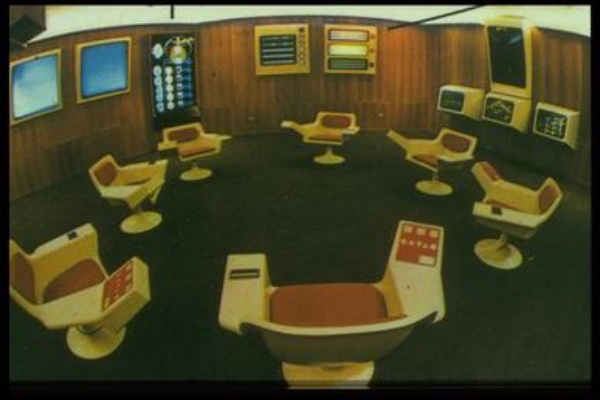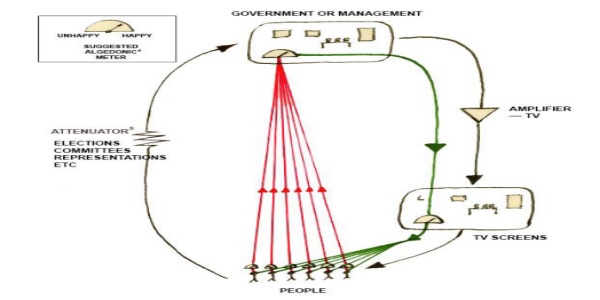Project Cybersin
We rarely look to older technologies for inspiration. That’s bad.
The historical experiences of less industrialized nations can teach something about the technological problems of today.
This is the case, says Jacobin, of a computing system built in socialist Chile in the 1970s.
Project Cybersyn emerged in the early 1970s, after Salvador Allende had won the Chilean presidency with a promise to build a fundamentally different society.
Giving the state control of Chile’s most important industries constituted a central plank of Allende’s platform. The problem of how to manage them was tackled by a young Chilean engineer named Fernando Flores, and a British cybernetician named Stafford Beer.
The system they would build, called Cybersin as in “cybernetics synergy”, would provide daily access to factory production data and a set of computer-based tools that the government could use to predict future economic behavior.
Cybersin also included this futuristic operations room that would facilitate government decision-making through conversation and better comprehension of data:

<u><em><strong>CAPTION:</strong>
<a href="https://en.wikipedia.org/w/index.php?curid=12937653" target="_blank">Cybersin Control Room. Source: Wikipedia. Click for license</a>
</em></u>
Also, quoting from “Project Cybersyn and the origins of the Big Data nation” one wall of the Control Room was reserved for Project Cyberfolk:
“an ambitious effort to track the real-time happiness of the entire Chilean nation in response to decisions made in the op room. …From their living rooms, [citizens could] move a pointer on a voltmeter-like dial that indicated moods ranging from extreme unhappiness to complete bliss. The plan was to connect these devices to a network—it would ride on the existing TV networks—so that the total national happiness at any moment in time could be determined.".

<u><em><strong>CAPTION:</strong>
<a href="http://s3.amazonaws.com/arena-attachments/1626765/9cf2acf081171e0bfb5a7f34f0167bc7.pdf?1516553248" target="_blank">Project Cyberfolk. Click for license</a>
</em></u>
The real innovation of Cybersin was not technology
It was how it used technology to really involve in government as many citizens as possible:
- Beer envisioned ways to both increase worker participation in the economy and preserve the autonomy of factory managers, even with expanding state influence.
- Allende’s government pushed for… integration of worker knowledge in economic decision-making.
- So, in 1972, Beer published to the Chilean government to give Chilean workers, not managers or government technocrats, control of Project Cybersyn, starting from participating in its design
Can you imagine something like that in practically any contemporary country, regardless of its government?
We know better today. And still..
For example, we know , or so I hope, that the idea of instantaneous democracy via dials or any other means is naive, just like direct democracy is naive.
Also, it seems that the Control Room had buttons because it had to be used, without intermediaries, by “factory workers and government bureaucrats” which were almost exclusively male, in a time when only female secretaries knew how to use keyboards.
Another naive, weak spot in Beer’s vision was, apparently, its ideas for democratic participation: “he didn’t consider how coding worker knowledge into the software of a computer system might result in the eventual disempowerment of workers, especially if the political context changed”.
Nevertheless, “Beer’s framework is useful because it reminds us of the importance not just of computational transparency, but of democratic control. If code is law, as Lawrence Lessig famously proposed, then the code used in the new technologies that shape our lives should not be the exclusive domain of engineers and programmers”.
So, as the Jacobin articles concludes, “while the project was far from perfect, its lessons should not be ignored by those seeking a future where technology is democratically harnessed for social good."
Do yourself a favour: after this post, do read an unexpected analysis of our digital economy. Then, come back and follow the sources of this post, to read more about Cybersin. It’s both fascinating and useful.
Who writes this, why, and how to help
I am Marco Fioretti, tech writer and aspiring polymath doing human-digital research and popularization.
I do it because YOUR civil rights and the quality of YOUR life depend every year more on how software is used AROUND you.
To this end, I have already shared more than a million words on this blog, without any paywall or user tracking, and am sharing the next million through a newsletter, also without any paywall.
The more direct support I get, the more I can continue to inform for free parents, teachers, decision makers, and everybody else who should know more stuff like this. You can support me with paid subscriptions to my newsletter, donations via PayPal (mfioretti@nexaima.net) or LiberaPay, or in any of the other ways listed here.THANKS for your support!